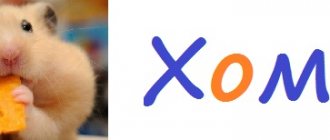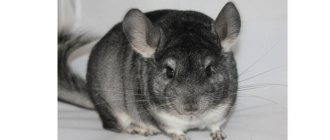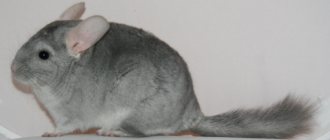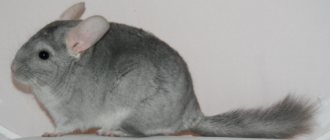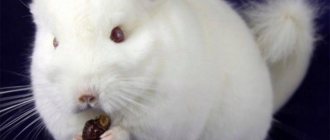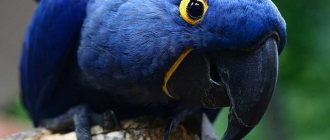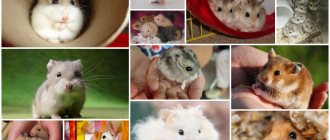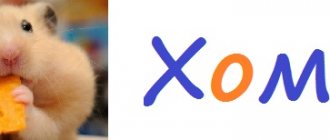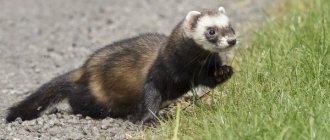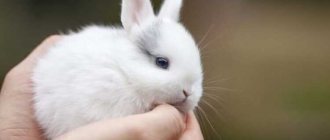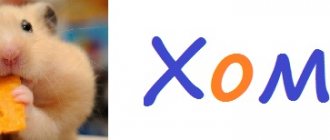- home
- Chinchilla
- Character and features
03/25/2019 There is a generally accepted opinion that the only chinchilla color is gray. However, this is not the case. For decades, breeders have been trying to develop fluffies with interesting colors. This article contains useful information about what colors of chinchillas can be found in nurseries.
Varieties of chinchillas
These animals come in two types, which differ in the size of the body and the size of the tail:
- Large short-tailed chinchillas (Peruvian) are native to Bolivia and some areas of the Argentine Andes. The fur of this chinchilla breed is so valuable that you will no longer see them in the wild. Today, such animals are raised only on farms. The short-tailed chinchilla has a strong body of 40 cm, weight 800 g. The tail is short with hard hair.
- Common, long-tailed (shore) chinchillas are still found in the Chilean Andes. They have a small body and an elongated tail covered with fur. Weight does not exceed 700 g.
Both chinchilla breeds are endowed with a gray color. Through selection of the Lesser Longtail, over 40 different colors of magnificent fur coats have appeared.
Angora chinchilla
The Royal Angora Chinchilla is a subspecies of the long-tailed chinchilla. Interestingly, it was not specifically bred. It was nature itself that gave us an animal with such a beautiful long coat.
The first rodents with this mutation were noticed in the 60s of the last century. However, the standard was described in 2001. Breeding the subspecies is extremely difficult. A pair of Angoras is likely to give birth to ordinary babies with short hair. Therefore, breeding such rodents requires high professionalism when selecting pairs.
Angora has a long silky coat, which is decorated with a luxurious tail. Another distinctive feature is the long fur on the head and paws. The muzzle is flattened, so these chinchillas have another “folk” name - Persian. The rarest individuals have the colors of black velvet, blue diamond, and violet.
Angora chinchilla is the most expensive. The cost of one copy can be several thousand dollars. The fur is so valuable that the high cost of the animal has been maintained for several decades.
Dwarf chinchillas
A natural genetic mutation caused the birth of mini chinchillas with a small body, short legs and a bushy tail. Weight does not exceed 300 g.
The dwarf chinchilla produces cubs of the same size as those of normal females. The miniature mother has a hard time giving birth. Often newborns do not survive. During pregnancy, the female is under the supervision of specialists. The colors of these cute fluffies can be varied.
Results
These pussies can be the subject of a lucrative business. A description of the chinchilla breed with a photo and name will help in choosing animals. When breeding these rodents, keep in mind that gray and beige rodents are easier to breed, but are more common. They are cheaper. Sapphire and violet are rare colors, more expensive, but much more difficult to breed. The breeder has to study many nuances and strictly follow them. Therefore, to maintain the financial well-being of the farm, it is necessary to think through a reasonable balance between breeding different species of this beautiful and amazing animal.
Work continues to breed new species. Scientists from different countries are studying this problem. The animal is of great interest both as a pet and for industrial purposes.
Chinchillas support the household. They are attached to their owner tenderly and for a long time. Of great interest is the breeding of animals in pairs, when you can observe love and friendship that can be envied.
Color options
In the wild, animals have many enemies. An inconspicuous and dim grayish fur coat is one of the shields. Rodents are less noticeable against the background of rocks.
Since people became interested in animals, white, black and beige breeds have been brought into the world. The result of many years of breeding research is rare colors. Today it is difficult to imagine that nature originally endowed this fluffy with only one color.
The entire palette of fur coats can be divided into the following groups:
- gray or agouti, which are considered standard;
- white with varying saturation or an admixture of pink, beige;
- brown or pastel, available in all colors, including chocolate;
- black with varying degrees of saturation;
- original fur coats in purple, sapphire and pink colors.
Animal colors are:
- Dominant, which are visible from birth.
- Recessive, when the rodent is only a carrier of the gene that is responsible for a certain fur color.
For breeding work, it is important to know what recessive color a rodent has.
Standard gray
Gray chinchillas exist in nature and in captivity.
There is a division by shade and depth:
- light;
- average;
- dark;
- moderately dark;
- extra dark.
This is the native color of wild chinchillas and their ancestors. Darker color on the back. The sides are light, the belly is snow-white. Color distribution on the hair: from gray-blue at the base to black at the crown.
What distinguishes individuals with gray colors is their health. They begin to bear offspring early. You can cross with any subspecies. The fur is pleasant and soft to the touch.
Light
A light gray fur coat with a silver tint looks very impressive. In such animals you can see a light shirt-front, abdomen, and paws.
Average
It is considered the typical and most common color. The body is a uniform gray color, lighter on the belly, chest and paws.
Dark
Gray fur with a blue tint and lighter coloring on the belly and chest makes rodents stand out from the general gray mass.
Moderately dark
Such animals have a dark gray coat that turns into spectacular ash on the paws, face and sides. Their belly is bluish-white.
Extra dark
Many fans have charcoal-gray chinchillas with light sides and chest. Their bellies are light beige.
Breeds with white fur
White chinchillas look elegant and representative. They have their own nuances.
White Wilson
Rodents, which are called white Wilson, are “dressed” in a white coat with possible admixtures of grayish or beige colors:
- Silver mosaic. The animal has a white fur coat with a silvery tint and dark fur on the head and base of the tail.
- Light mosaic. Rodents have light gray spots on a pure white coat. The scruff and ears are dark gray.
White chinchillas are not uncommon in nurseries. Breeders are willing to raise it, the color is in demand
Albino
Animals are not identified as a separate breed. An albino is an animal that lacks color pigment at the genetic level. Has milky fur and red eyes.
White Lova
A representative of an interesting variety of chinchillas is the White Lova. He has a white coat with a cream tint. Beautiful eyes the color of dark ruby.
White velvet
Rodents are carriers of a pleasant light velvet coat, which can be beige or silver. It is distinguished by expressive gray spots on the front legs and head.
White-pink
The milky coat of the rodent, which has black eyes and pinkish ears, produces a stunning effect. An individual with a pink back looks even more interesting.
Nutrition rules
The Persian chinchilla has the disadvantage of a tendency to gain excess weight. Therefore, high demands are placed on owners: in order for the cat to be healthy, it is necessary to approach the preparation of the pet’s diet with all responsibility.
You can feed Persian cats:
- premium dry food for British and Persian breeds;
- natural products.
Those who prefer to feed their pet dishes made from natural products should know that the most beneficial for chinchillas are:
- beef, boiled chicken;
- offal;
- vegetables (with their addition to fish or meat dishes);
- fish (sea low-fat);
- eggs.
Cats can add bone meal to their dishes. Do not forget also that such cats should always have fresh water in their bowl.
Such handsome chinchillas with expressive eyes and a calm, balanced character can truly become the decoration of any home and a true friend for everyone who sees tenderness and kindness in them.
Animals with beige color
Beige chinchilla (pastel) may have variations in shades. The older the animal, the darker its coat will be. It can be red, beige, brown. Animals are allowed to crossbreed.
Beige homozygous
Homobeige rodents with uniformly colored light beige fur have pink ears. The fur has no shading zoning; single hairs with dark “tops” are acceptable.
Heterobeige
Heterobeige, on the contrary, has uneven color. The entire fur is beige, and the undercoat and ends of the hairs are dark brown.
A heterobeige chinchilla with yellowness indicates a deterioration in breed qualities.
When choosing an animal, you must definitely consider the color line between the belly and the rest of the body.
Beige Tower
An animal with a coat color ranging from light to dark beige in combination with a brown ornament on the back looks intriguing.
Wellman's beige
A gentle little animal with light beige fur, delicate light ears and, as a contrast, black beady eyes.
Sullivan's Beige
The rodents that bear such a beautiful name have a rich beige coat and red eyes.
Brown velvet
These types of chinchillas have beige fur as a base, and their back and head are chocolate. The abdomen is sand-colored, sometimes almost white.
Ebony breed
The main difference between this chinchilla breed is not the color, but the quality of the fur. It shines extraordinarily and shimmers in the light. The color palette can be varied.
Homoebony
Black ebony is a rare type of color. The animals have a coal-black coat and black eyes. The second name for animals is charcoal.
Heteroebony
The shiny dark coat of heteroebony rodents combines two palettes: black and gray. Both options are great and eye-catching at exhibitions.
White ebony
There are chinchillas with a shining snow-white coat, which is given a special charm by black coating at the ends of the hairs. The paws, head and beginning of the tail can be gray or beige.
What kind of character do queens have?
The Persian chinchilla attracts everyone who interacts with it with its kind disposition. These are very smart animals: they love to be in the company of their owners, but when alone they can feel sad, watching, for example, birds outside the window, or simply dozing on their favorite sofa.
But still, a feature of the cat’s character is great curiosity and temperament. These cats love to play and will always find something to do if their owners have no time to communicate with them.
They enjoy spending time with children, but cannot tolerate other cats on their territory. This is a little selfish, but demanding that the owners pay attention only to themselves is evidence of affection for them. They accompany their owner wherever he goes, but they prefer not to run away from home. A measured lifestyle, unhurriedness, tranquility - this is for them.
Breeds of chinchillas with dark fur coats
Among the homoebony with rich black fur, the “black velvet” breed is distinguished.
Black velvet
The contrast of black and white is always mesmerizing. Fluffies with black fur on the body and tail combined with a light belly look amazing. The clearer the border of contrasts, the more valued the breed is.
The variety was bred in the 60s of the last century. It is believed that dark fur indicates the high quality of the breed. Black Velvet is distinguished by its markings: light stripes on its paws, charcoal mask, darkened fur on its head. The older the animal, the more clearly the breed characteristics are expressed. Breeders warn: the gene is lethal. Crossing “velvet” animals is prohibited. This will end badly for the mother and cubs.
Rare breeds
The most expensive chinchillas have a rare and amazing color. Breeders have developed interesting breeds of animals that cause genuine delight.
Violet
The fabulous light lilac fur of the body contrasts with the white belly. There is a purple impurity on the nose and ears.
The lavender color is passed on through the first and second generations. Rodents become sexually mature late. The ability to produce offspring occurs by one and a half years.
Sapphire
Bluish-gray or light blue fur with a graphite veil in combination with a white belly and pink ears looks simply amazing. The eyes are shiny black. Sapphires are one of the most expensive and sought after chinchillas.
Color appears by 7–8 months. It is better to purchase younger rodents with a declared sapphire color in specialized nurseries.
Blue Diamond
Pedigree chinchillas with light blue fur, a metallic tint and a dark pattern on the ridge and head are more valuable than sapphire ones.
White and pink diamond
Animals with a pearl coat and a shade of rose are considered rare. Ears are harmonious pink.
Animals have a lethal gene, so they cannot be paired together. They will make an excellent pair with rodents of other coat colors.
Is it possible to be allergic to a pet?
There are many myths circulating that chinchillas do not cause allergies. However, these speculations are completely untrue. Animal fur causes allergic reactions less often than things necessary to care for it
If a person is prone to allergies, then before getting such a pet it is important to visit a chinchilla breeder. It’s worth holding the animal in your hands and observing your reaction.
Sometimes increased sensitivity in the owner occurs even after the chinchilla has lived with him for a long time. Every doctor will advise you to get rid of your pet and all its belongings. But how can you part with your pet so easily? Before taking drastic measures, it is worth trying other options. The first weapon will be an air purifier, with its help it will become easier to breathe. Don’t be lazy once again to carry out wet cleaning in your home and your pet’s.
Simple rules will help you protect yourself from allergies:
- Use a mask when cleaning the cage. This way, dust from the filler and animal fur will not get into the respiratory tract;
- Be sure to wipe the cleaned enclosure with a damp cloth;
- Pressed filler can easily replace ordinary sawdust;
- Swimming is best done in a non-residential area with good ventilation.
Crossing chinchillas
The variety of colors is a boon for skilled breeders. The process of crossing is very exciting, since there is always the possibility of the manifestation of a recessive gene of one of the parents in the offspring.
There is a serious limitation when making a pair. You cannot combine two lethal genes: white and black. This will lead to the death of newborns. The female may also die during the period of bearing babies.
To successfully crossbreed rodents, breeders are issued animal passports. The document officially states which genes the pet is a carrier of. The possible color of the cubs is calculated using a color calculator.
White Wilson
Story
It is believed that the name of this place was given in honor of Mrs. Wilson. According to some reports, it was on her ranch that these furry animals appeared. At first, the breeder thought the animal was an albino because of its white color. But when the White chinchilla gave birth, it became clear that this was a new type of color.
Wilson White chinchilla
Color
This breed has different color variations. From snow-white to dark. Which color will depend on the crossing.
It is worth noting that no matter the shade of the coat, the ears and eyes remain unchanged. Other breeds of chinchillas usually have black eyes and ears. White Wilsons, on the other hand, are usually gray or dark gray. The beginning of the tail is surrounded by a dark ring. The belly and limbs are white. The main black of this species is the snow-white tip of the tail.
If there is a yellow color in the fur, this indicates a mixture of the breed and poor quality wool.
The most common color types are:
- Tricolor;
- Platinum;
- Mosaic;
- Silver.
The mosaic coloration is similar to that of Dalmatians. Her fur is covered with dark spots that have different shapes. This color is considered to be inherited. The value of such fur is determined by the symmetry of the dark spots and their saturation.
Platinum coloring is distinguished by a gray coating over the entire surface of the fur.
The silver color is highlighted by the color of the tips. The tips of this color are gray, which creates the illusion of a silvery coating.
The rarest is the tricolor. With this color, three colors can be seen on the animal’s fur: gray, white and black. Stripes and spots on the fur form a unique pattern. Chinchillas are generally bred for their fur and the profitability of the business. Therefore, this color has one of the highest prices on the market. Increases the cost of both the chinchilla itself and its fur.
Contents of the White Wilsons
This type of pet does not require special care. They only need:
- Spacious and equipped cage (house, running wheel, etc.);
- Bathing;
- Special diet.
Chinchillas prefer to move by jumping. Therefore, the cage must be high enough. It is desirable that it have a variety of shelves, ladders, and tunnels.
It is believed that pets develop better if each of them has their own house. This will help avoid quarrels between them and speed up reproduction.
The room where the chinchillas are kept should be between 18 and 20 degrees Celsius. Exposure of your pet to the sun and drafts is fraught. To prevent the animal from suffering from the heat in the summer, you need to install an air conditioner.
To grind a clove, a salt stone must be installed. In addition to grinding, the salt stone contains many microelements and minerals that are useful for the animal.
Chinchillas are considered quite active animals; they often scatter food and sand. The cage must be kept in frequency and disinfected at least 2 times a month.
Nutrition
It is worth feeding herbivore food. It contains useful elements that accelerate growth (flour, oats, wheat, salt, fat, etc.) The addition of green food is not prohibited:
- Oat or wheat sprouts;
- Young nettle greens;
- Horse sorrel;
- Dandelion or plantain.
On average, two to three tablespoons of food per day is enough for one individual.
The most important feature of the diet is hay. Hay helps your pet's digestion. Also helps in grinding teeth, preventing the development of dental hooks on the rear incisors. Just don’t give it in large portions, otherwise the rodent will scatter it around the house.
It is recommended to give: various fruits, nuts, grapes, figs.
This pet should not be overfed; it has a very weak stomach.
Bathing is an integral part of grooming. not in water, but in sand. This means that the cage must have containers with sand, which contains antibacterial additives. This sand feels like fine dust. If it is rough, hard and the touch causes discomfort, then it can harm the pet’s skin.
